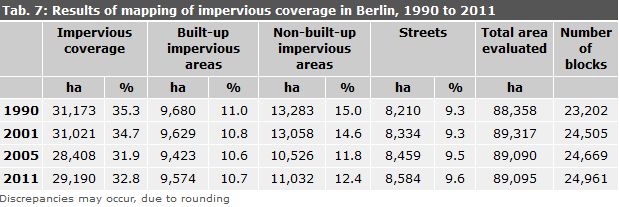It is notable that the values ascertained for the impervious built-up area over the years are almost identical. This indicates that the old ascertainment methods yielded values that were quite good on the average, since the surveys of 2005 and 2011 using the ALK can be considered very precise.
For the non-built-up impervious areas, the picture is somewhat different. Here, the values ascertained for 2005 decreased by 2.8 percentage points compared with 2001, and increased by 0.9% between 2005 in 2011. The decrease between 2001 and 2005 may on the one hand be due to the fact that on the old maps, some green and open-space categories (e.g. Forest and Farmland) were assigned estimated values for their non-built-up impervious portions, values which we today recognize as having been too high. Since these areas constitute a major share of the municipal area, the degree of impervious coverage was overestimated for the non-built-up impervious areas overall. On the other hand, due to the problems mentioned above regarding the interpretation of the satellite data, the non-built-up impervious areas were more likely to be underestimated under the new method. These assumptions are rather more plausible than the
supposition that any reduction in impervious areas actually took place in the municipal area.
With regard to the ascertainment of impervious roadways, the roughly estimated values available in 1990 could not be replaced by values from the Road-Building Authority until 1997. These were used for the evaluations in 2001. For the impervious coverage mapping projects in in 2005 and 2011, degrees of impervious coverage for streets, recorded by borough based on 2006 data, were obtained for the entire city (Gerstenberg & Goedecke 2011). A slight increase in the degree of impervious coverage attributable to the streets category and caused by road-building measures, primarily in East Berlin, certainly seems plausible.
The multiple use of the new procedure in 2011 also permits a comparison with the impervious coverage at block level. Figure 8 maps the changes between 2005 in 2011. Blocks with changes of greater than 10 % of the degree of impervious coverage are shown. However, in the overall accounting of the impervious coverage in the total area and at the level of sector types, smaller changes have also been incorporated.
Investigations during the development of the procedure showed that the ascertainment of the built-up impervious surface was very precise (cf. Validation 2007). For the ascertainment of the non-built-up impervious areas, the precision is not as good. This is due to the following reason:
- Due to the correction of ISU sector types in 2010, pseudo-changes occurred in 718 blocks.
- In the SPOT5 satellite image scene of 2005, there were much larger shaded areas than in 2011. These were classified specific to the surroundings. In the comparison, different impervious coverage values could even occur when using the same evaluation methods.
- For 244 block sectors, the block geometries was changed considerably between 2005 in 2010, causing pseudo-changes to appear in the impervious coverage map.
- For 37 block sectors, there were no SPOT5 satellite image scenes available in 2005. These sectors were entered into the comparison for 2005 as 0 % impervious. However, since most of them involved forest areas east of Müggel Lake, the error here must be considered minimal.
For these reasons, only blocks with changes in overall impervious coverage of greater than 10 % are shown in the map of impervious coverage changes between 2005 in 2011.





